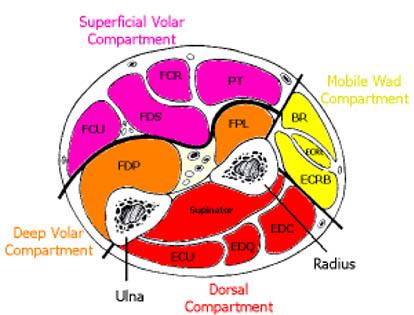Unlocking the Secrets of Hand & Forearm Compartment Syndrome: Causes, Symptoms, and Treatment
Hand & Forearm Compartment Syndrome are devastating upper extremity conditions where the osseofascial compartment pressure rises to a level that decreases perfusion to the hand or forearm and may lead to irreversible muscle and neurovascular damage.
Hand & Forearm Compartment Syndrome: Causes, Symptoms, and Treatment
Summary
Hand & Forearm Compartment Syndrome are devastating upper extremity conditions where the osseofascial compartment pressure rises to a level that decreases perfusion to the hand or forearm and may lead to irreversible muscle and neurovascular damage. Diagnosis is made with the presence of severe and progressive hand or forearm pain that worsens with passive finger or wrist motion, respectively. Firmness and decreased compressibility of the compartments is often present. Needle compartment pressures are diagnostic in cases of inconclusive physical exam findings and in sedated patients. Treatment is emergent fasciotomies.
Epidemiology
Anatomic Location:
May occur anywhere that skeletal muscle is surrounded by fascia, but most commonly:
- Leg
- Forearm
- Hand
- Foot
- Thigh
- Buttock
- Shoulder
- Paraspinous muscles
Etiology:
Pathophysiology:
Local trauma and soft tissue destruction > bleeding and edema > increased interstitial pressure > vascular occlusion > myoneural ischemia
Causes:
- Trauma
- Fractures (most common)
- Distal radius fractures in adults
- Supracondylar humerus fracture in children
- Crush injuries
- Contusions
- Gunshot wounds
- Tight casts, dressings, or external wrappings
- Extravasation of IV infusion
- Burns
- Postischemic swelling
- Bleeding disorders
- Arterial injury
Anatomy
Forearm Compartments:

3 in total:
- Volar (most commonly affected)
- Dorsal
- Mobile Wad (lateral, rarely involved)
Muscles:
- Brachioradialis
- Extensor carpi radialis longus
- Extensor carpi radialis brevis
Hand Compartments:

10 in total:
- Hypothenar
- Thenar
- Adductor pollicis
- Dorsal interosseous (x4)
- Volar (palmar) interosseous (x3)
Presentation:
The most common symptom of Hand & Forearm Compartment Syndrome is pain that is out of proportion to the clinical situation. Other symptoms include difficult to assess paraesthesia and hypoesthesia, paralysis, palpable swelling, and absent peripheral pulses.
Evaluation:
The diagnosis of Hand & Forearm Compartment Syndrome can be made through physical examination, radiographs to rule out fractures, and compartment pressure measurements in cases with inconclusive physical exam findings or sedated patients. The threshold for decompression is controversial, but generally considered to be within 30 mm Hg of diastolic blood pressure.
Treatment:
Treatment for Hand & Forearm Compartment Syndrome is emergent fasciotomies. Nonoperative treatment may be considered for cases not consistent with compartment syndrome or with a delta p > 30. Operative treatment involves decompression through forearm and hand fasciotomies. Post-operative care includes leaving the wounds open, wound VAC or sterile wet-to-dry dressings, and repeat irrigation and debridement. Skin grafting may be performed for delayed primary wound closure.
Complications and Prognosis:
Complications of Hand & Forearm Compartment Syndrome include Volkman's ischemic contracture, loss of function, neurologic deficits, infection, and amputation. Volkman's ischemic contracture is characterized by irreversible muscle contractures in the forearm, wrist, and hand that result from muscle necrosis. The prognosis for Hand & Forearm Compartment Syndrome varies and may lead to long-term functional impairments.
Arm Compartment Release - Lateral Approach:
The operative technique for arm compartment release using the lateral approach involves making an incision from the deltoid insertion to the lateral epicondyle, splitting the fascia over the biceps anteriorly and posteriorly, checking the integrity of the soft tissue, leaving the incision open, copiously irrigating the wound, covering the incision with wet saline dressings or a wound vac, and performing 2nd look procedures if needed.
"Devastating Upper Extremity Conditions: Understanding Hand & Forearm Compartment Syndrome"
Preoperative Patient Care:
Prior to the surgery, a comprehensive evaluation and management of the patient is conducted including obtaining a focused history and performing a focused exam, interpreting basic imaging studies, making an informed decision to proceed with surgical intervention, and providing post-operative management and rehabilitation.
Operative Techniques:
The preoperative plan involves executing a surgical walkthrough, ensuring proper room preparation including surgical instrumentation and patient positioning. The lateral approach is used for the arm compartment release, where the incision is made, deep dissection is performed, and wound management is carried out. A 2nd look procedure may be performed to debride necrotic tissue and cover the wounds.
Conclusion:
Hand & Forearm Compartment Syndrome is a serious condition that requires early diagnosis and emergent treatment. Proper evaluation, accurate diagnosis, and prompt surgical intervention can help prevent long-term complications and improve patient outcomes.
"From Pain to Permanent Damage: Exploring Hand & Forearm Compartment Syndrome"

